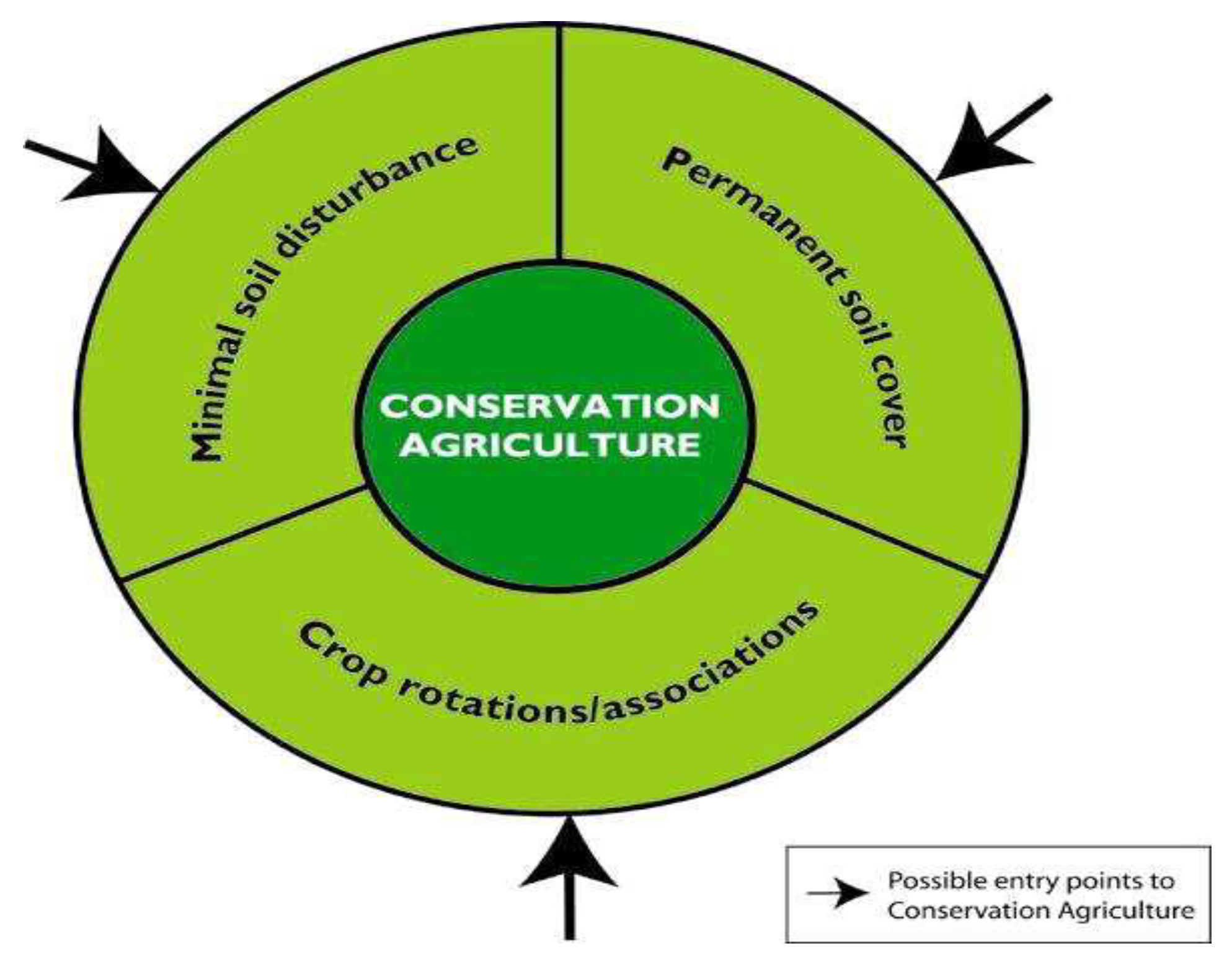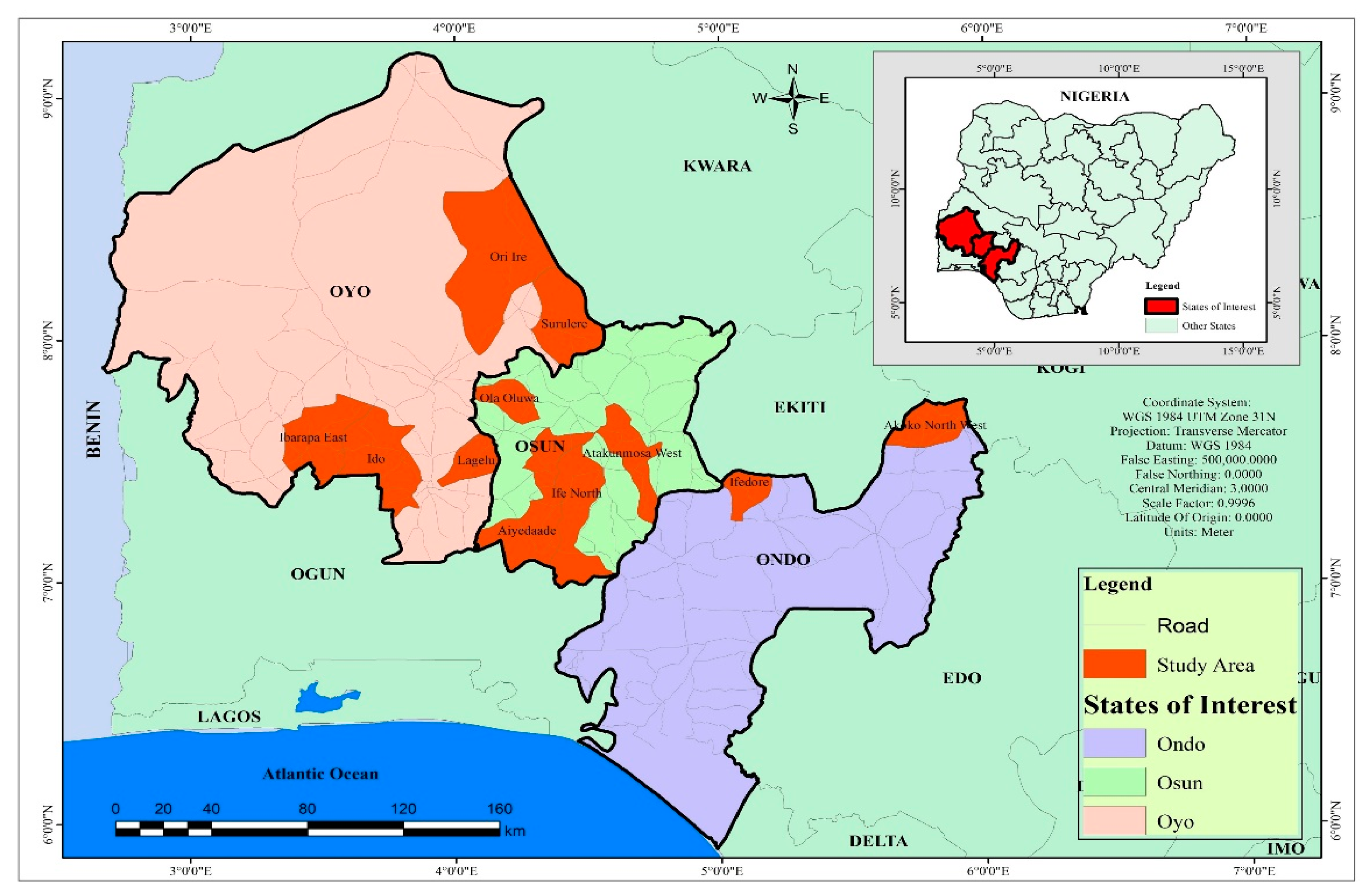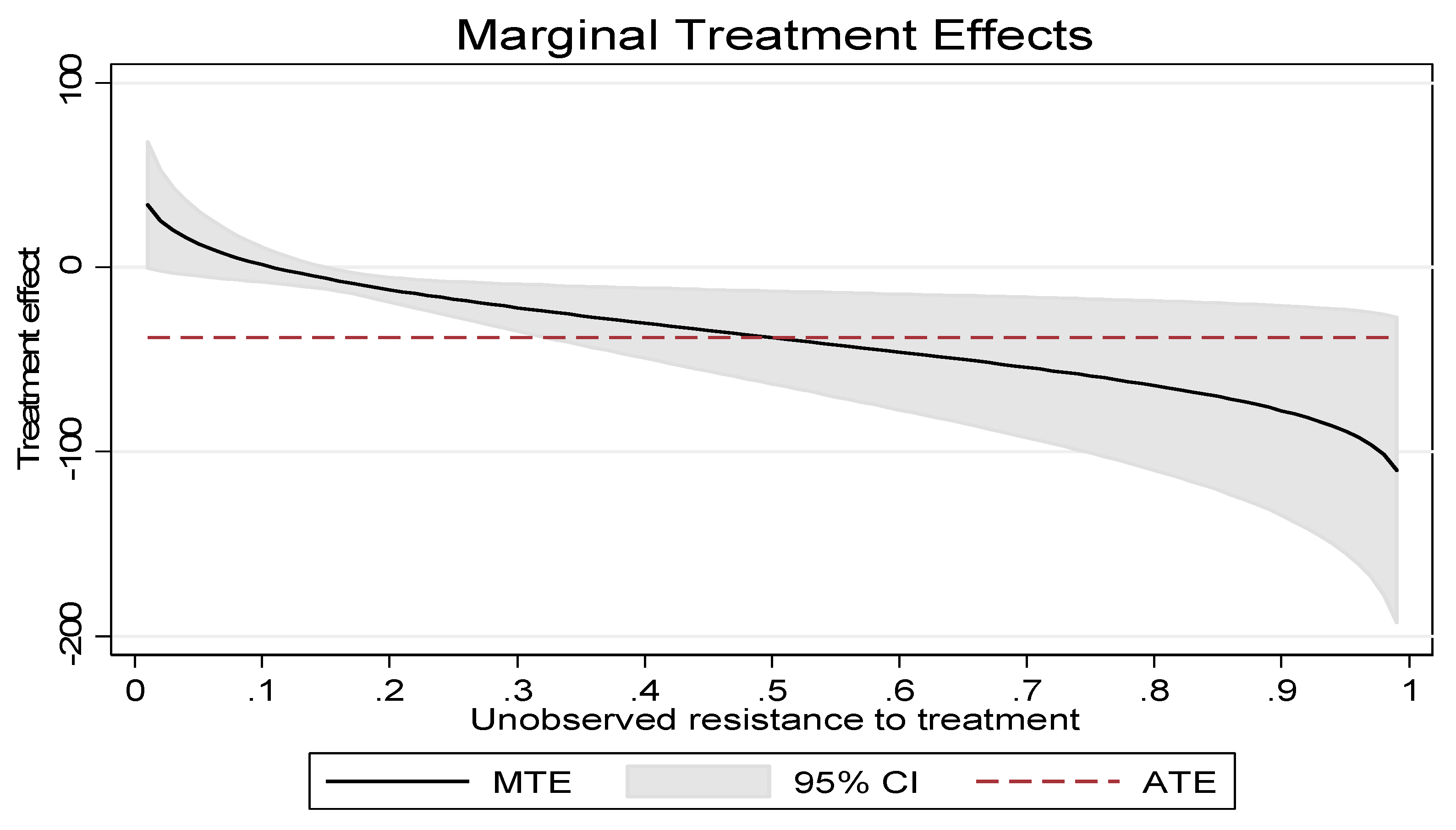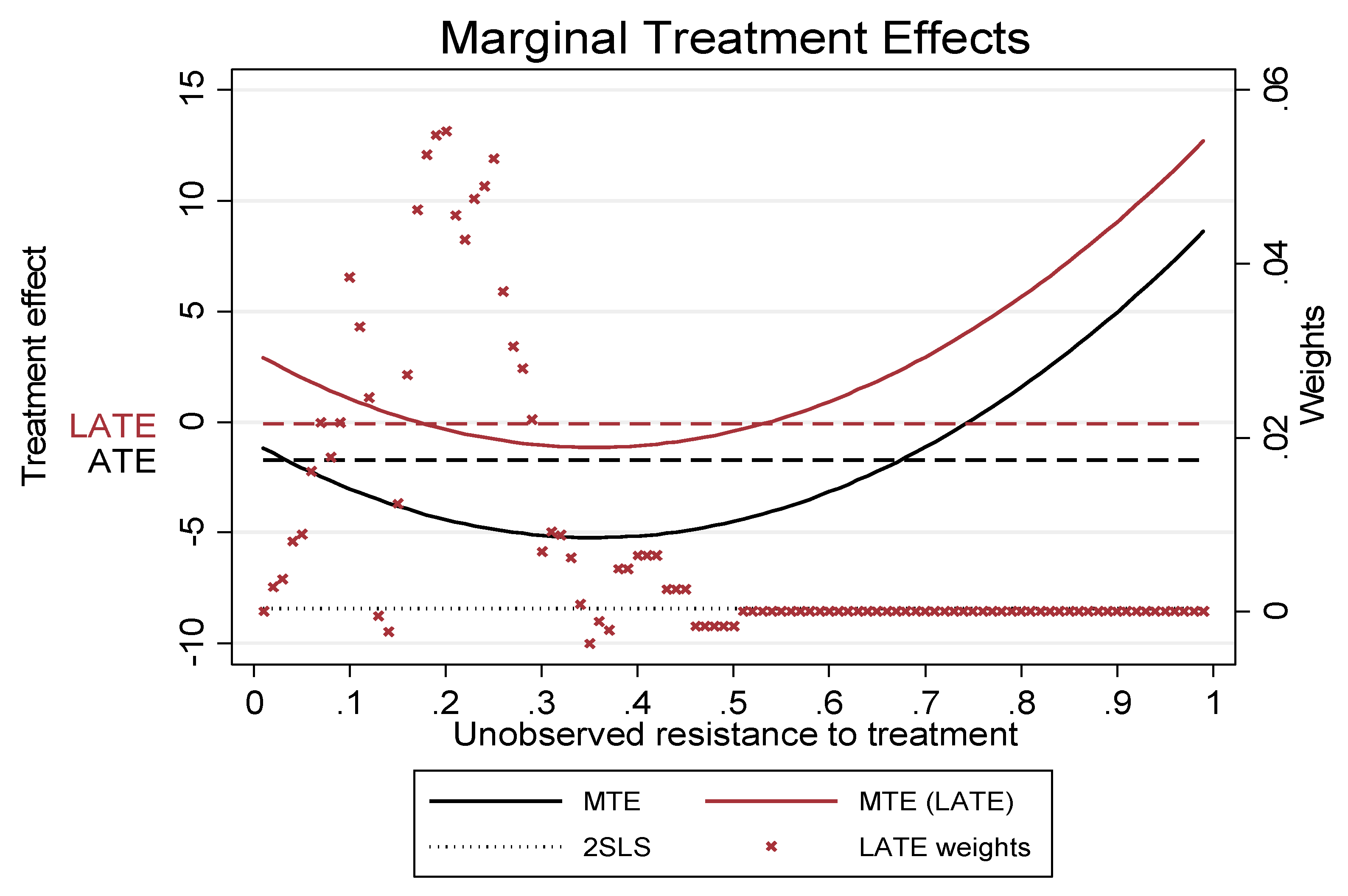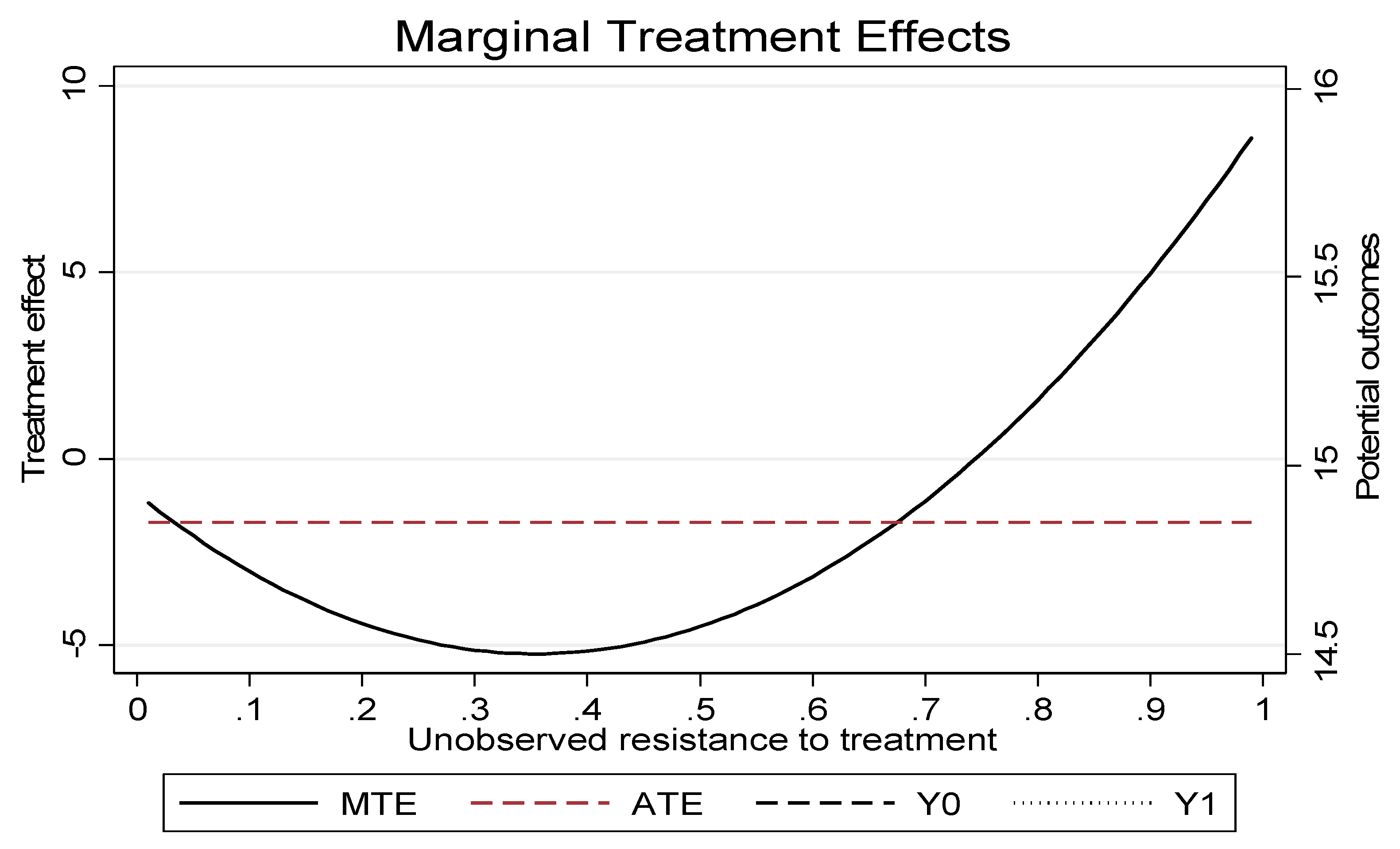3.2.1. Poisson and Negative Binomial Distribution Models: Empirical Results
The estimation of Poisson distribution regression model (PRM) and the associated goodness-of-fit tests indicated that the Poisson estimation suffers from over-dispersion problem as expected. Evidently, the Pearson’s goodness-of-fit test result shows that the distribution of CA practices adoption counts significantly differs for a Poisson distribution. Consequently, the unacceptably large value obtained and recorded for chi-square in the post estimation (likelihood ratio test) is an indication that the Poisson distribution model is not a suitable option because over-dispersion is suspected. This estimation is consistent with the guidelines provided by Baum [
59]. In lieu of this, it is clearly impossible to make any meaningful inference from the Poisson regression model estimates to avoid a misleading conclusion. Given the distribution of data, the negative binomial distribution model was considered an appropriate option over the Poisson model to address the over-dispersion issue. More so, the incident rate ratio (IRR) of the negative binomial regression model was computed and reported as suggested by Piza [
60] to show the impact of explanatory variables in terms of a percentage change in the observed response variable (in this case, counts of CA practices adopted). In essence, “the IRR represents the change in the response variable in terms of a percentage change, with the precise percentage determined by the amount the IRR is either above or below 1” [
60]. Equally, it is important to stress that, count regression techniques model the
log of incident counts [
54].
The findings indicated in
Table 2 report the fitted negative binomial regression model. Similarly, the statistical significance (
p < 0.01) of alpha coefficient, and the likelihood ratio test of alpha also attest to the non-appropriateness of the Poisson regression model. Therefore, this permits a strong rejection of the null hypothesis that the errors do not exhibit an over-dispersion problem. Hence, the negative binomial model is deemed fit for describing the influencing dynamics governing smallholder farmers’ adoption count of alternative CA practices in the study area. These procedures and findings are in tandem with Pedzisa [
8] whose study investigated the intensity of adoption of CA by smallholder farmers in Zimbabwe. The result from
Table 2 revealed that, for every one unit increase in the male gender compared to the female counterpart, the
log count of CA practices adopted by female gender is expected to increase by approximately 0.76; with an estimated statistical significance (
p-value) of 0.099 (that is,
p < 0.1). A viable explanation for this is that, increase in the count of CA practices adopted by male gender serves as a positive motivating factor for the female counterpart to increase the count of CA practices adopted by them in a bid to also achieve maximum benefits accrued from CA adoption. Similarly, for every unit increase in the number of social groups to which farmers belong, the
log count of CA practices adopted is expected to decrease by approximately 0.20. This suggests that membership in many social groups significantly (
p < 0.01) influences the
log count of CA practices adopted in the study area, though with inverse relationship. This result reinforces earlier findings that there is a persistent information gap among members of various social groups; rather much focus is placed on the social events than sharing useful information about improved and beneficial agricultural techniques such as CA.
On the other hand, the results also indicated that, for every one unit increase in human capital designate-total years of farming experience, the log count of CA practices adopted is expected to increase by approximately 0.01; suggesting that a unit increase in the years of farming experience significantly (p < 0.1) increases the log count of CA practices adopted by the smallholder farmers in the study area. This result is in line with a-priori expectations. Expectedly, frequency of contact with extension agents was found to have a direct and significant (p < 0.05) influence on the log count of CA practices adopted. This implies that, for every one unit increase in the frequency of extension visits in the study area, the log count of CA practices adopted is expected to increase by approximately 0.14. By implication, such visit is expected to induce positive adoption behavior among the smallholder farmers. In the same vein, the likelihood ratio test shown in the negative binomial model output is a test of the over-dispersion parameter alpha. The results of the Wald test revealed that, alpha parameter is significantly different from zero which of course reinforces the earlier submission that the Poisson regression model is not appropriate for the distribution of the count data under consideration.
According to Piza [
60], the interpretation of the results is more or less similar with all the count regression models. This implies that model parameters tend to communicate the same information in both Poisson and negative binomial regression models. The author further noted that reporting IRR can communicate clearly and precisely the influence of explanatory variable influence on the outcome variable than the model regression coefficient. Hence, it is more tenable to report the incidence rate ratio of the negative binomial regression model in estimating the influence or effect of the explanatory variables on the response variable than reporting regression coefficients arising from Poisson or negative binomial distribution models. This position was also upheld by Cameron and Trivedi [
61] as well as Long and Freese [
52]. However, the IRR estimates in
Table 2 revealed that, CA adoption count is expected to decrease by a factor of 0.80 or approximately 20% with every unit increase in male gender, given that other explanatory variables in the model are held constant. This suggests that male gender compared to female counterparts is expected to have a rate of 0.80 points less for count of CA practices adopted. In the same vein, holding all other covariates in the model constant, the IRR value of 0.82 for density of members in social groups suggests a factor of 0.82 or an approximately 18% decrease in the count of CA practices adopted. This is also an indication that diffusion of information about relevant agricultural technologies is a “missing gap” among the social groups in the study area. Conversely, as expected, if farmers’ years of farming experience were to increase by one unit, count of CA practices adopted is expected to increase by a factor of 1.01 or approximately 1%, while holding other explanatory variables in the model constant. Furthermore, the findings also indicated that, all things being equal, CA adoption count is expected to increase by a factor of 1.14 or approximately 14% with every point/unit increase in the frequency of visits by extension agents, given that all other explanatory variables in the model are held constant. Conclusively, gender of the farmer (
p < 0.1), farmers’ years of farming experience (
p < 0.1), frequency of visits by the extension agents (
p < 0.05), and density of social group membership (
p < 0.01) significantly drive the count of CA practices adopted or rate ratio for CA adoption by smallholder farmers in the study area. Importantly, the basic CA practices adopted by farmers to preserve the ecosystem services in preferential order are: sequential rotation practice for different unrelated crops, the use of crop biomass for permanent soil cover, as well as minimum soil tillage. These findings partly agree with Abebe and Sewnet [
62] who investigated determinants of soil conservation practices adoption in North-West Ethioia. Findings from their study indicated the influence of farmers’ and plot-level features, human capital, trainings and institutional support as the main drivers of adoption but never considered the role of social capital in adoption process which our study emphasized on. The importance of social capital in agricultural technologies adoption was also noted in the studies conducted by Hunecke et al. [
10] and Husen et al. [
9].
Similarly, the computed average marginal effects estimates in
Table 3 revealed that, after controlling for other variables, on the average, farmers with appreciable years of farming experience used about 0.089 (8.9% points) of CA practices more than those with fewer years of experience in farming, and on average, farmers who were constantly in touch with extension officers adopted 0.896 (89.6% points) of CA practices more compared to those with less contact. Conversely, on the average, farmers who belong to many social groups adopted 1.304 points of CA practices less than those who belong to fewer social groups. The implication of this is that activities of social groups in the study area tend to tilt towards social engagement alone other than sharing useful and beneficial information about agricultural technologies. This result also reinforced the earlier submission made about the social groups in the study areas. Meanwhile, as indicated in
Table A2, the evaluation of information measures (that is, Akaike’s and Bayesian Information Criterion—AIC and BIC) clearly revealed that negative binomial regression model fits better, owing to a smaller AIC and BIC statistics values. This is in line with Williams [
54,
63].
3.2.3. Marginal Treatment Effects Estimates: Empirical Results
The MTE model estimation was fitted through local IV and separate approach estimators with reference to parametric assumptions. However, the local IV was favored due to the model performance. The output from this estimation as shown in
Table 4 highlights the impact evaluation of the specified covariates on the outcomes as measured by farmers’ farm income. Likewise, the differences in the average outcomes across the fitted covariates could be inferred directly from the first panel of the output as indicated by
β0. In this instance, the coefficient for years of farming experience in the first panel of the output table indicates that one more year of farming experience translates into approximately 1.83% higher income, albeit with a non-linear effect. Arising from this, it is difficult to confidently infer that it is the actual effects of extra years of farming experience that drives the higher income if we fail to observe a strong exogeneity assumption as required on the fitted covariates. Equally, the coefficient of farm size under CA system from the first panel of the output table also suggests that an extra hectarage of farm size leads to about 25.22% decrease in farmers’ income. However, without accounting for strong exogeneity assumption on this factor, this reason alone cannot substantiate the farmers’ inability to produce within the production possibility frontier, given the economies of scale in terms of farm size increase.
In a similar manner, the second panel of the output with
β1 −
β0 in
Table 4 explains the observed differences in treatment effects across covariate values, which also indicates treatment status and covariate interactions. Thus, the coefficient for gender indicates that a male farmer has 6.12 points higher advantage in terms of income generated as a result of CA adoption. The coefficient for age of the farmers suggests that an increase in age translates to about a 34.2% increase in farmers’ income, while an extra year of formal education suggests a farmer has about a 40.2% increase in income. However, the estimated coefficient for years of farming experience suggests than an increase in this farmers’ characteristics translates to approximately 10.86% decrease in the farmers’ income, while an extra increase in farm size under the CA system suggests about a 2.93-point increase in farmers’ income ceteris paribus. Similarly, an increase in the farmers’ total farm size indicates an approximately 1.02-point decrease in these farmers’ income which is somewhat erroneous and contrary to expectation; given the economies of scale in terms of farm size increase and all else equal, an increase in total farm size is expected to drive increased farm output and by extension, increased farmers’ income. The results also indicated that social capital is a significant factor towards CA adoption, but the benefits of social interaction is not maximally explored based on the direction of movement of this variable; that is, an increase in social capital benefits was found to drive an approximately 1.27-point decrease in farmers’ revenue. More so, the coefficients of extension delivery services (i.e., access and frequency of access) translated to about an 8.02-point decrease and a 5.34-point increase in farmers’ income, respectively, suggesting that the performance of an extension delivery system in the study area was not optimal. Importantly, for regional factor influence, a region (that is, Oyo State region) was arbitrarily set to be the basis of comparison since few research institutes (such as the International Institute of Tropical Agriculture (IITA)) are domiciled in this region. Therefore, compared to the counterpart farmers in region1 (Oyo State), the coefficients of region2 and region3 (Osun and Ondo states) suggest that an increase in adoption of CA by farmers in these regions will induce about a 4.29-point decrease and a 6.61-point increase in farmers’ income, respectively, all else equal. However, drawing conclusions on the treatment by relying on these findings alone without accounting for the possible non-linear effects may be erroneous and misleading for a valid, tenable, and causal inference about these findings.
To this effect, the third panel in the output table addressed this concern where under different treatment effects parameters and policy changes. The full distribution of marginal treatment effects parameters presented include: average treatment effects (ATEs), average treatment effects on the treated (ATT), average treatment effects on the untreated (ATUT—the spill-over effects), as well as the policy relevant treatment effects (MPRTEs—which points at the average effects of making marginal shifts to the propensity scores for both the treated and untreated individuals). This is also necessary to fully understand the treatment effects heterogeneity in relation to the framework guiding MTEs potential from a hypothetical policy that shifts the propensity to choose treatment which is the CA adoption. More importantly, as noted by Zhou and Xie [
64], this approach preserves all of the treatment effects heterogeneity that is consequential for selection bias. In lieu of this, the output from the third panel highlighting the average difference in the outcome between the treated and untreated groups revealed that ATT > ATE > ATUT > LATE
0; such that, income is higher among the farmers who adopted the CA system than the counterparts who did not adopt CA for whom average income is virtually zero. More so, these treatment effects parameters are statistically significant at various levels; but an exception is made of ATT which is not significant at any level. However, MPRTEs estimated under the stylized policy changes represented by MPRTE
1, MPRTE
2, and MPRTE
3 respectively indicate a substantial marginal income among these farmers (treated group). It is important to note that the exact magnitude of MPRTE depends heavily on the form of the policy change, especially under the normal parametric model which this study considered. For instance, under the first policy change where the policy changes increase everyone’s probability of adopting CA by the same amount, the parametric estimate of MPRTE is −8.527, suggesting that an extra effort to adopt CA would translate to about an 8.5-point decrease in farmers’ income among the marginal entrants on CA adoption. Equally, under the second policy change where this change favors farmers who appear more likely to adopt CA, the marginal income is approximately a 7.3-point decrease if there is a change in policy that permits and increases everyone’s probability of adopting CA proportionally. Besides, this scenario can even go as high as about a 12.5-point decrease in income under the third policy change where the change favors those farmers who appear less likely to adopt CA. However, the same pattern of results is observed under the polynomial MTEs model. The implication of this is that a different policy experiment could increase or decrease CA adoption, depending on which individuals it induces to gain and attract the expected spread and exposure.
In addition, considering the
p-values for the two statistical tests shown in
Table 4, the first one represents a joint test for the second panel of the output
β1 −
β0, which is also a test of whether the treatment effect differs across the covariates. The second one indicates a test for essential heterogeneity, which is also a joint test of all coefficients in k(u). From all indications, the first test revealed that the treatment effects differ significantly across the covariates in the second panel of output while the second test indicated that the treatment effects vary significantly with unobserved heterogeneity in the sample. Evidently, there are significant differences in the treatment effects across the sample. Therefore, this finding suggests that different policy scenarios or situations could increase or decrease CA adoption, depending on which individuals it induces to attract the expected spread and exposure. However, for parametric joint normal assumption using local IV,
Figure 3 and
Figure 4 depict the density distribution of propensity scores, MTE curve plot, as well as the associated confidence intervals for the treated and untreated farmers. This will permit to make necessary inferences about the common support. In this case, downward sloping of the estimated MTE plot is observed, with relatively high treatment effects at the beginning of the
UD distribution (addressing propensity not to be treated), which eventually declines to negative effects at the right end of the distribution. This pattern of slope (downward) is in tandem with Roy model which predicts a positive selection on unobservable benefits.
For robust estimation, this study further applied parametric polynomial MTE model and the separate estimation approach by relaxing the joint normal distribution assumption as well as plotting MTE curves for both normal and polynomial functions of the MTE models as indicated in
Figure 5 and
Figure 6, respectively. Here, the MTE plot for normal is downward sloping with negative treatment effects, which is consistent with the first estimate while MTE plot for the polynomial is relatively flat at the start of the
UD distribution. This eventually slopes upward above zero towards the tail end of the
UD distribution. Similarly, treatment parameter weights were estimated and the resultant plots are shown in
Figure 7. In this case, the MTE curve at the average of the covariate and the MTE curve for adopters are evidently convex upward; that is, the plots slope consistently upward without overlapping from the start to the end of
UD distribution. This suggests that farmers are motivated to adopt CA because of the instrumented participation in collective action (social capital) have different values of covariate. Therefore, this influences the treatment but not the outcome. However, the weight distribution indicated that the adopters have a much lower probability to have unobserved resistance towards the mid-point of the distribution. This further suggests that the farmers have MTEs slightly above the average. Hence, the farmers (adopters) who are influenced by the instrument are the ones with slightly above average increase in farm income. Similarly, separate estimation procedure was carried out in fitting the polynomial model by plotting the resulting potential outcomes to investigate if the observed MTE downward plot trend is generated by upward slopping of
Y1, and downward sloping of
Y0, or a combination of the two scenarios. Recall that the difference between outcome for the treated
Y1 and outcome for the untreated
Y0 represents MTE. Therefore, the plot as shown in
Figure 8 indicated that though these farmers are relatively similar, the farmers who have high resistance to treatment perform poorly in terms of income realized from farm output than their low resistance counterparts who are also adopters. Hence, it can be inferred that, all else equal, there is a substantial effects and impacts of the treatment (that is, adoption of CA practices) on the farmers’ farm income.
